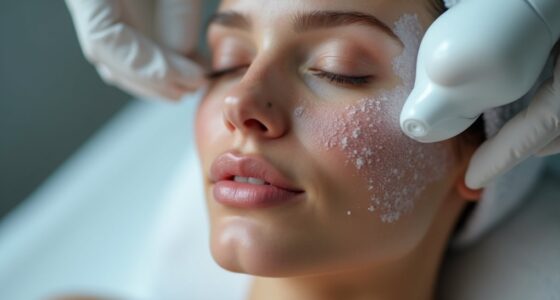Heat therapy stimulates collagen production by increasing blood flow and activating cellular repair processes. When you apply heat, it triggers heat shock proteins that promote tissue resilience and support collagen synthesis. This boosts fibroblast activity and enhances skin elasticity and joint health. As your cells respond to heat stress, they adapt and improve tissue resilience over time. Continue exploring to discover how you can use heat therapy effectively for youthful skin and healthier joints.
Key Takeaways
- Heat therapy increases blood flow and metabolic activity, supporting cellular repair and collagen synthesis in skin and tissues.
- Controlled heat stress activates heat shock proteins that promote collagen production and tissue regeneration.
- Elevated temperatures stimulate fibroblast activity, essential for producing and maintaining collagen in tissues.
- Heat activates signaling pathways (e.g., MAPK, PI3K/Akt) that enhance collagen gene expression and tissue resilience.
- Regular heat therapy can improve skin elasticity, reduce joint stiffness, and support long-term tissue health through collagen enhancement.
Understanding Collagen and Its Role in the Body
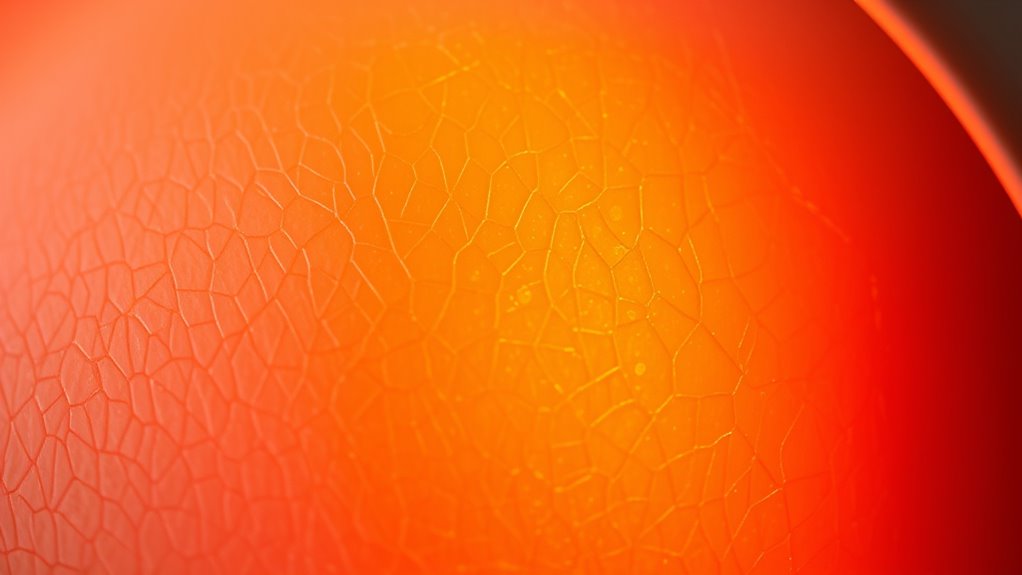
Collagen is the most abundant protein in your body, providing structure and strength to your skin, bones, tendons, and ligaments. It’s a key type of structural protein that maintains the integrity of your tissues. There are several collagen types, each serving specific roles: Type I supports skin, bones, and tendons; Type II is found in cartilage; and Type III helps with skin elasticity. These structural proteins form a supportive framework that keeps your body’s tissues resilient and flexible. As you age, collagen production decreases, leading to wrinkles, weaker joints, and reduced skin elasticity. Understanding these types helps you grasp why collagen is essential for your overall health and why maintaining its levels is crucial for tissue repair and youthful appearance.
How Heat Therapy Influences Cellular Processes
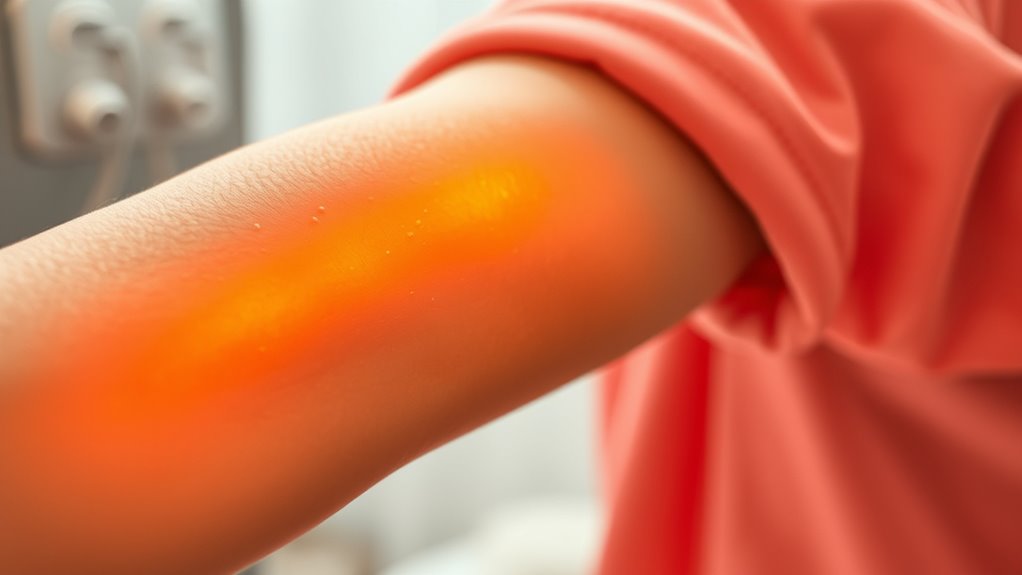
Heat therapy affects cellular processes by increasing blood flow and enhancing metabolic activity in targeted tissues. When you apply heat, your cells experience heat stress, which triggers adaptive responses to cope with the elevated temperature. This cellular adaptation improves nutrient delivery and waste removal, supporting tissue repair and regeneration. Heat stress also activates signaling pathways that promote cellular resilience, encouraging the production of proteins crucial for healing. As your cells respond to heat, they become more efficient at managing stress, leading to improved overall function. This process not only boosts circulation but also primes your tissues for further healing. Research indicates that heat therapy can influence cellular processes by inducing controlled heat stress, which helps optimize cellular functions that are essential for tissue health and collagen synthesis.
The Biological Mechanisms Behind Heat-Induced Collagen Synthesis
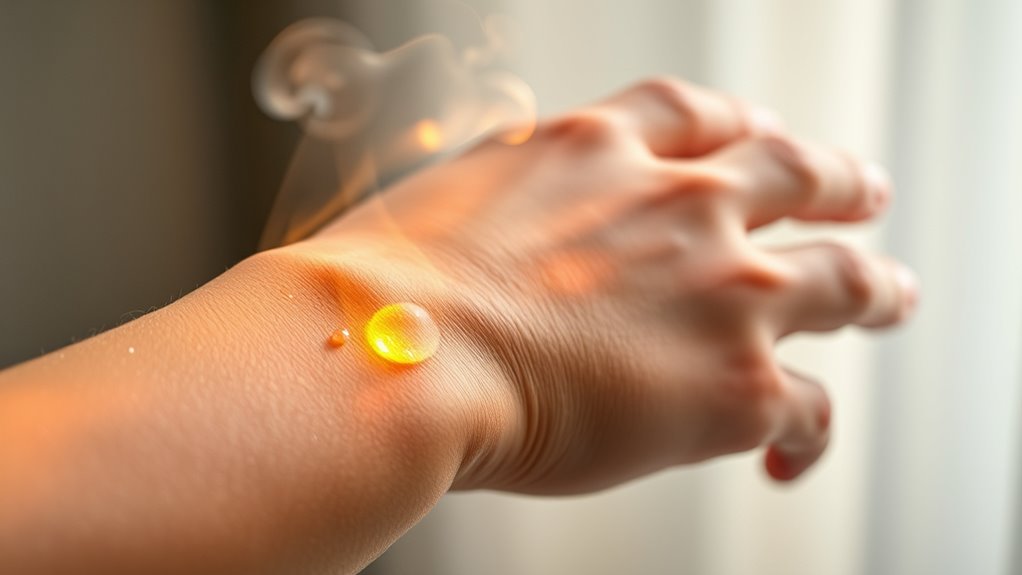
When you apply heat therapy, your cells respond by activating specific heat shock proteins that protect and repair tissue. This response triggers the activation of genes responsible for collagen production, boosting synthesis. Understanding these mechanisms reveals how heat uniquely promotes healthier, more resilient skin. Additionally, research suggests that managing oxidative stress during heat exposure can further enhance collagen synthesis and skin health.
Cellular Heat Response
Understanding how cells respond to heat reveals the biological processes that stimulate collagen production. When exposed to heat, your cells activate specific cell signaling pathways that trigger repair and growth. This response promotes thermal adaptation, helping your skin withstand future heat stress. Here’s what happens:
- Heat shock proteins are produced, protecting cells and facilitating collagen synthesis.
- Cell signaling pathways, like MAPK and PI3K/Akt, are stimulated, encouraging collagen gene expression.
- Cellular stress prompts adjustments in metabolism, improving tissue resilience and promoting healthy collagen levels.
- The production of heat shock proteins enhances cellular repair mechanisms, further supporting collagen synthesis.
Collagen Gene Activation
The process of collagen gene activation is driven by the cellular signaling pathways triggered during heat exposure. When you apply heat, it stimulates genetic regulation mechanisms that turn on specific genes responsible for collagen production. Heat can induce epigenetic modifications—changes in gene expression without altering DNA sequences—that enhance collagen synthesis. These modifications may include histone adjustments or DNA methylation shifts, making genes more accessible for transcription. As a result, your cells increase the production of collagen-related proteins. This activation process is a pivotal step in how heat therapy promotes skin health and elasticity. By influencing both genetic regulation and epigenetic factors, heat exposure effectively amplifies your body’s natural ability to generate collagen.
Scientific Studies Exploring Heat and Collagen Production
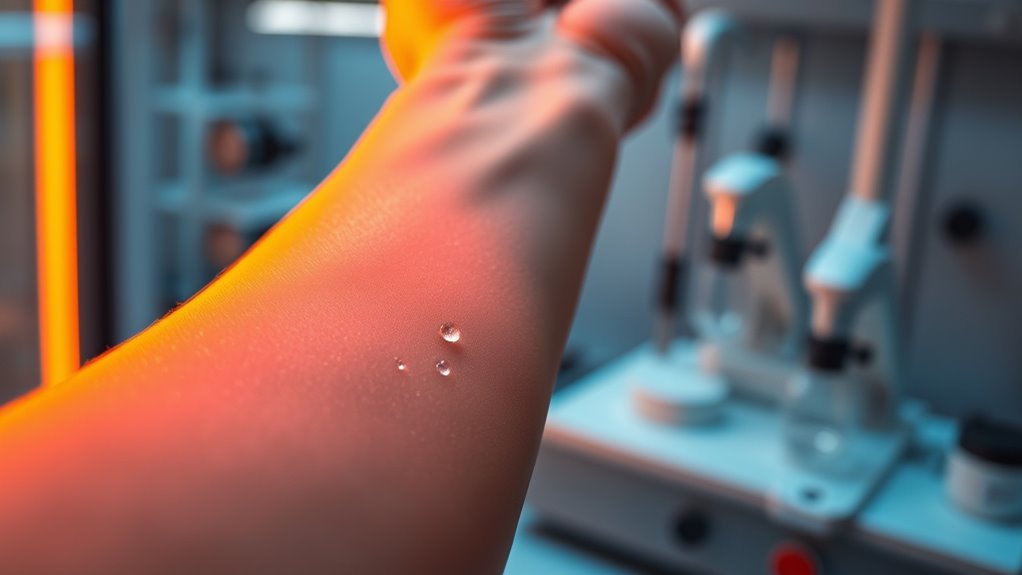
Numerous scientific studies have investigated how heat therapy influences collagen production, revealing promising results. These studies show that applying heat triggers thermal regulation responses, activating heat shock proteins that promote collagen synthesis. When your body experiences controlled heat exposure, it initiates cellular repair and boosts collagen levels, improving skin elasticity and joint health. Notably:
- Heat therapy increases collagen gene expression by stimulating heat shock responses.
- Elevated temperatures enhance fibroblast activity, key to collagen production.
- Consistent thermal regulation can lead to longer-term improvements in skin and tissue integrity.
- Incorporating mindful relaxation techniques during heat therapy sessions can further enhance the body’s response, promoting better collagen synthesis and overall relaxation.
Research highlights that managing heat exposure effectively can optimize collagen growth. The body’s response to heat shock demonstrates how carefully controlled heat therapy can support your skin and joint health naturally.
Practical Applications of Heat Therapy for Skin and Joint Health
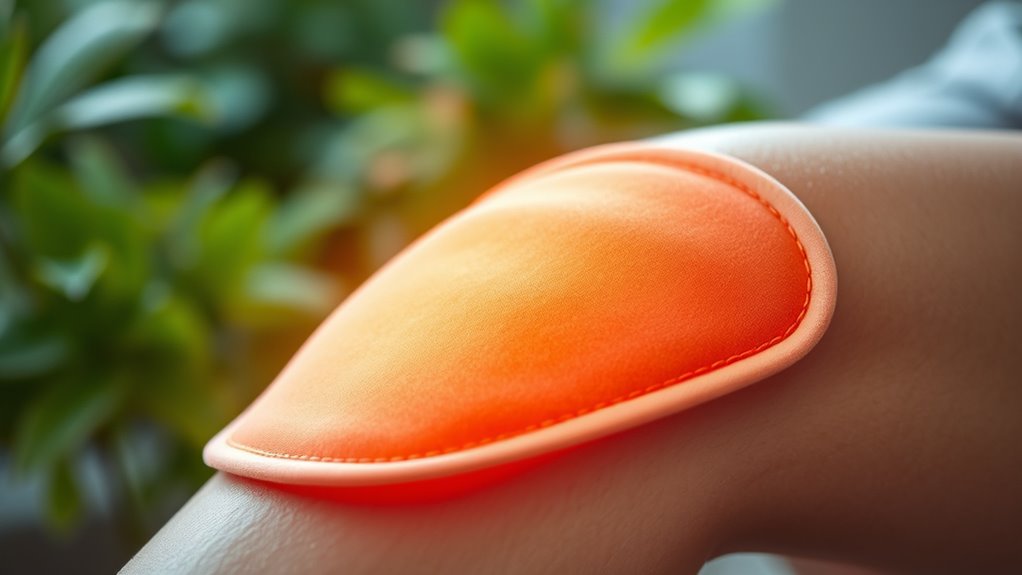
You can use heat therapy to naturally improve your skin’s elasticity and give it a more youthful appearance. It also helps reduce joint stiffness, making everyday movements easier and less painful. Plus, applying heat can boost collagen synthesis, supporting long-term skin and joint health. Ensuring proper installation and venting while using heat therapy devices is essential to prevent safety hazards.
Enhancing Skin Elasticity Naturally
Applying heat therapy can be an effective way to boost your skin’s elasticity naturally. When you focus on thermal comfort and relaxation techniques, you encourage increased blood flow, which supports collagen production and skin resilience. To maximize benefits, try these practical tips:
- Use warm compresses or heated pads to gently warm your skin, promoting collagen synthesis.
- Incorporate relaxation techniques like deep breathing or meditation during heat sessions to enhance overall relaxation and skin health.
- Maintain consistent sessions, ensuring your skin feels comfortably warm without overheating, to optimize collagen production and improve elasticity.
- Combining heat therapy with proper hydration can further support skin health and elasticity.
Reducing Joint Stiffness Effectively
Heat therapy offers a practical and effective way to reduce joint stiffness by increasing blood flow and relaxing tight muscles. When combined with traditional remedies like warm compresses or heated herbal packs, it can provide immediate relief. You might also consider herbal supplements known for their anti-inflammatory properties, which support joint health from within. Applying heat helps loosen stiff joints, making movement easier and reducing discomfort. For best results, incorporate heat therapy into your routine regularly, especially before activities that worsen stiffness. Remember, combining heat with natural remedies offers a holistic approach that enhances effectiveness without relying solely on medications. Sound vibrations are also believed to enhance cellular regeneration and overall health, further supporting joint recovery. This simple, accessible method can markedly improve your joint function and mobility over time.
Boosting Collagen Synthesis
Building on the benefits of heat therapy for joint mobility, it also plays a significant role in boosting collagen synthesis, which is essential for skin and joint health. Heat-induced vasodilation increases blood flow, delivering nutrients that stimulate collagen production. This process improves collagen fiber alignment, making tissues stronger and more elastic. To maximize these benefits: 1. Use heat therapy regularly to encourage consistent collagen synthesis. 2. Apply heat to promote heat-induced vasodilation, enhancing nutrient delivery. 3. Focus on areas needing improved collagen fiber alignment, like skin or joints, for prime results. Incorporating heartfelt father love daughter quotes can also inspire a nurturing approach to self-care and overall well-being.
Future Directions and Potential Benefits of Heat-Driven Collagen Boosting
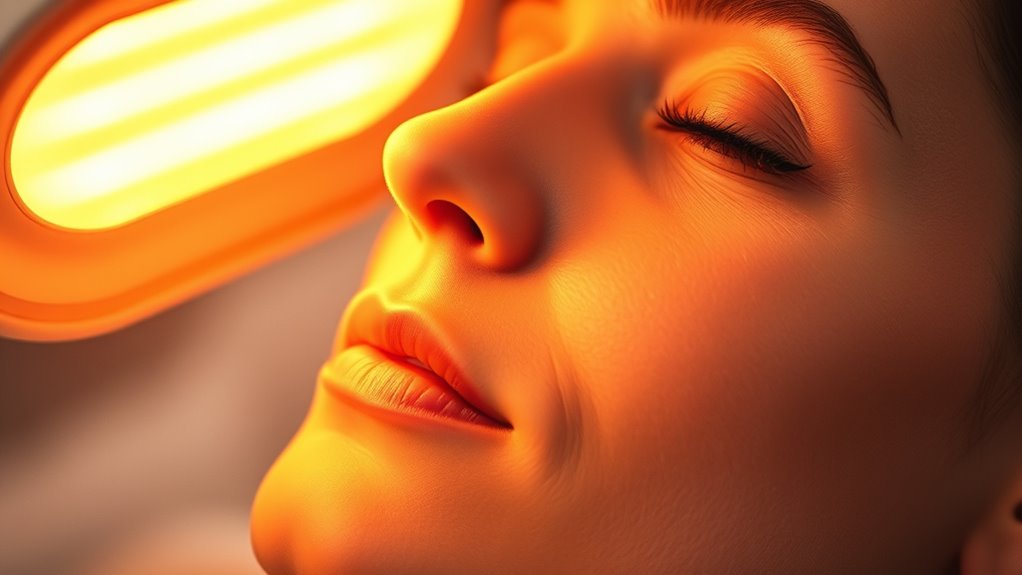
As research progresses, the potential for heat-driven methods to markedly enhance collagen production becomes increasingly promising. Future advancements could lead to innovative device development tailored to maximize benefits for individuals. Personalized treatment protocols will likely emerge, optimizing heat application based on skin type and collagen needs. These customized approaches may improve safety and effectiveness, making collagen boosting more accessible. Here’s a glimpse of potential benefits:
| Benefit | Application | Impact |
|---|---|---|
| Faster results | Targeted heat therapy | Reduced recovery time |
| Enhanced safety | Precise device control | Minimized side effects |
| Greater accessibility | Home-use devices | Broader reach |
| Customization | Personalized protocols | Better outcomes |
| Long-term effects | Sustained collagen growth | Improved skin health |
These directions promise a future where heat therapy revolutionizes skin care through tailored, efficient solutions. Advanced technology will likely play a key role in refining these methods for safer and more effective treatments.
Frequently Asked Questions
Can Heat Therapy Improve Collagen Production Naturally Without Supplements?
You wonder if heat therapy can boost collagen production naturally without supplements. It’s possible, as heat provides natural stimulation that encourages collagen enhancement by increasing blood flow and cell activity. Regular heat therapy treatments can help your body produce more collagen over time, supporting skin elasticity and joint health. While supplements can aid, consistent heat therapy offers a natural, drug-free way to promote collagen growth and overall skin vitality.
How Long Does It Take to See Visible Results From Heat Therapy?
You might wonder how long it takes to see visible improvements from heat therapy. Timing expectations vary, but generally, you could notice subtle changes within a few weeks of consistent treatment. For more significant results, it may take several months. Keep in mind, patience is key, and regular sessions boost your chances of achieving the desired collagen boost and healthier skin over time.
Are There Any Risks Associated With Excessive Heat Application on Skin?
You should be cautious about excessive heat application on your skin because it can lead to burn risks and skin damage. Overheating may cause redness, blisters, or more serious burns, especially if the heat source is too intense or applied for too long. Always follow recommended guidelines, avoid direct contact with very hot objects, and listen to your body’s signals to prevent harm and guarantee safe, effective heat therapy.
Is Heat Therapy Effective for All Skin Types and Ages?
You might wonder if heat therapy works for everyone. It generally benefits most skin types, but skin sensitivity varies. If you have sensitive skin or certain conditions, heat could cause irritation. Age considerations also matter; older skin may respond differently than younger skin. Always test a small area first, and consult a professional if unsure. Proper application guarantees safety and helps you get the most benefits from heat therapy.
How Does Heat Therapy Compare to Other Collagen-Boosting Treatments?
Ever wondered how heat therapy stacks up against other collagen-boosting treatments? You’ll find that thermal penetration from heat therapy stimulates collagen synthesis more gently, promoting natural renewal. Unlike invasive procedures, it’s safer for all skin types and ages. While treatments like laser or injections work faster, heat therapy enhances your skin’s own collagen production over time, making it a great, non-invasive option to contemplate in your skincare routine.
Conclusion
Imagine your skin as a sturdy brick wall, with collagen acting as the mortar holding it together. When you apply heat therapy, it’s like adding a fresh layer of mortar, strengthening and revitalizing your foundation. Studies show that heat boosts collagen production, helping your skin and joints stay resilient. So, next time you indulge in heat therapy, think of it as giving your body’s wall a much-needed repair, keeping you strong and healthy from the inside out.




